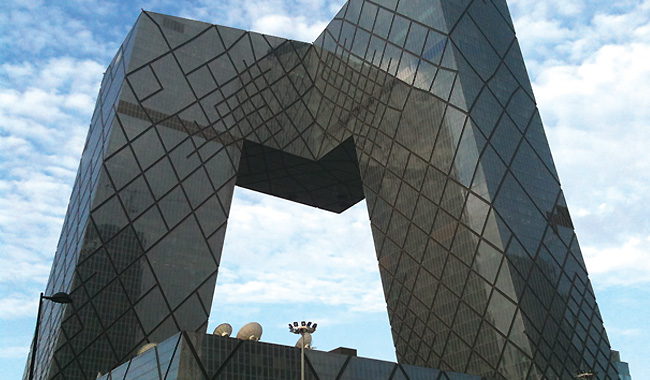
Sensor network used for structural health detection at the CCTV tower in Beijing
Led by Prof. Cao Jiannong, Chair Professor and Head of the Department of Computing, an interdisciplinary research team has developed a Structural Health Monitoring System that can provide real-time information on the structural health of bridges, high-rise buildings and towers throughout their life cycles.
Adopting "wireless synchronization" and "on-board storage", this system operates on an intelligent sensor network with two key advantages: radio- and vibration-triggered signals are used for fast and reliable wake-up, and in-network processing yields highly synchronized sensing data for users.
Using this comprehensive and prognostic system, life-cycle screening can be conducted to ensure the safety of mega-structures. Structural damage accumulated over time can be identified and structural health conditions can be assessed immediately after major hazardous incidents.
In recent years, PolyU has implemented the system in mega-structures such as the CCTV tower in Beijing and Hedong Bridge in Guangzhou. The system won a Special Mention Award and Certificate of Merit at the Hong Kong ICT Awards 2013. ♦
Smart sensors ensures structural health of mega-structures
An interdisciplinary research team at The Hong Kong Polytechnic University, under the leadership of Prof. Cao Jiannong, Chair Professor and Head of the Department of Computing, has developed a Structural Health Monitoring System, which can meet the practical needs of carrying out maintenance work and ensuring the safety of mammoth infrastructures. The system can provide real-time information on the structural health of mega-structures (e.g. bridges, high-rise buildings and towers) throughout their life cycles.
This PolyU-developed system, adopting "wireless synchronization" and "on-board storage", operates on an intelligent sensor network, and hence offering two major advantages. First, its radio- and vibration-triggered signals can be utilized for fast and reliable wake-up. Second, its in-network processing yields highly synchronized sensing data for users.
With the aid of this comprehensive and prognostic system, life-cycle screening can be conducted to check the condition of mega-structures. The system can identify structural damage accumulated over time, and it enables experts to spot structural damage at the earliest possible moment and carry out any necessary repair works. It can also assess structural health conditions immediately after major hazardous incidents.
In recent years, the system has been implemented in a number of prominent mega-structures throughout China, such as the CCTV tower in Beijing and Hedong Bridge in Guangzhou. For this achievement, The Hong Kong Polytechnic University has won worldwide recognition, including a Special Mention Award and Certificate of Merit at the Hong Kong ICT Awards 2013.
